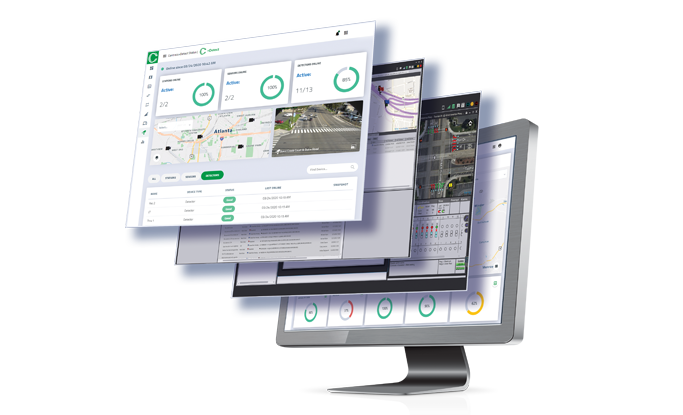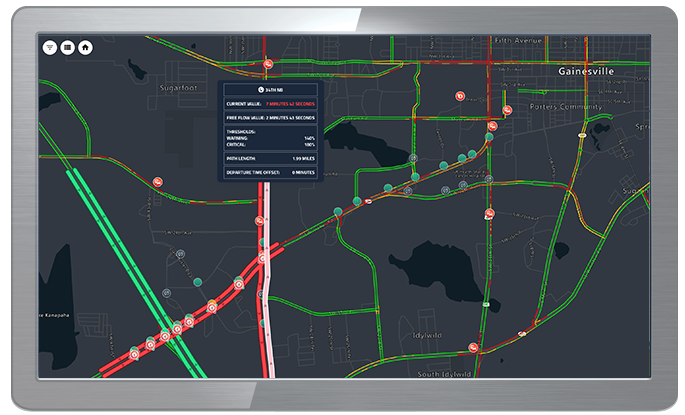Intersection and Corridor-Level KPI Reporting: Driving Performance in Traffic Management
As urban environments and climate change evolve, traffic management is no longer just about controlling signals, it must incorporate new levels of understanding Key Performance Indicators (KPI). It should also help support predictive automation and metrics that matter. Intersection KPI reporting and corridor KPI reporting are transforming how cities manage mobility. These KPIs offer deeper insights into traffic signal performance measures and enabling safer roadways and optimized traffic management.

What Intersection and Corridor-Level KPI Reporting Is
Intersection and corridor-level KPI reporting refers to the systematic collection, analysis, and visualization of KPIs as they pertain to traffic movement and traffic signal programming and operations. These KPIs provide actionable insights into how intersections and corridors are operating with regard to travel times, safety incidents, and non-reoccurring events. This helps city planners and transportation agencies continually optimize for mobility while improving safety.
At the heart of this approach are traffic Signal Performance Measures (SPM) and Automated Traffic Signal Performance Measures (ATSPM). These tools enable agencies to monitor real-time traffic conditions and aggregate historical trends. As a vital component to Dynamic Multimodal Network Management, KPI reporting delivers the traffic insights and data needed to support emerging dynamic traffic management strategies.
Key Metrics: Intersection and Corridor Performance Monitoring
Vehicle Delay
Vehicle delay measures the time vehicles spend idling at intersections or along a corridor due to red lights or congestion. High delay values indicate inadequacies in signal timing programs or unexpected events or incidents. Monitoring delays and identifying patterns helps agencies better respond to traffic signal timing plans or improve roadways. These insights can improve travel times and vehicle throughputs.
Queue Length
Queue length tracks the number of vehicles at an intersection approach. Excessive vehicle queues often impact upstream intersections, creating traffic gridlock. By analyzing vehicle queue data, traffic engineers can better tune signal phasing and identify problematic traffic patterns before they escalate.
Number of Stops
This metric tracks and counts how often vehicles are forced to stop along a corridor. A high number of arrivals on red lights can be an indication of poor traffic signal coordination. Reducing arrivals on red improves fuel efficiency, travel time, and mobility.
Green Time Distribution
Green light time distribution evaluates how green signal timing is allocated across different intersections. Balanced green time distribution ensures traffic smoothing and helps prevent traffic congestion. This metric is crucial for corridor performance monitoring.
Travel Time Reliability
Travel time reliability measures the consistency of travel times along corridors. Unpredictable and declining travel times negatively impact transit and commerce, as well as increase safety risks. If travel time decline is not addressed immediately, it can negatively impact entire transportation operations.
Why KPI Reporting Matters for City Planners and Traffic Engineers
The value of traffic KPIs extends far beyond operational efficiencies. They empower agencies to make more informed decisions, build resiliency, and deliver accessible mobility for all communities.
Data-Driven Decision Making
Access to real-time and historical traffic flow analytics, enables planners to make informed infrastructure decisions. KPI reporting provides the real-world data needed to justify policy for infrastructure improvements and investments.
Proactive Problem Solving
Traffic management has traditionally been a reactive process. By incorporating signal performance measures and AI-powered predictive applications, agencies can detect anomalies early and quickly intervene or make changes even before they become an issue. This shift to proactive traffic management is the next leap to Dynamic Multimodal Network Management.
Improved Traffic Flow and Reduced Congestion
By incorporating intersection performance metrics and continuous corridor performance monitoring, cities can identify inefficiencies and implement improvements. The result is smoother traffic flow, shorter travel times, and safer roadway networks.
Accountability and Performance Tracking
Intersection KPI reporting and corridor KPI reporting imparts transparency and accountability into traffic management operations. Agencies and cities can track the impact of policies and changes, quantify progress, and report outcomes to stakeholders. This fosters trust and supports continuous improvement.
Safety and Quality of Life
Incorporating traffic management KPIs into the overall transportation strategy, leads to safer roads and more accessible mobility. Metrics like queue length and arrival on red frequencies can highlight areas prone to dilemma zone risks and potential conflicts with Vulnerable Roadway Users (VRUs). By mitigating these risks, cities move closer to Vision Zero, and improve the quality of life for all residents.
From Reactive to Proactive: Evolving Traffic Management Strategies
Transitioning from reactive to proactive traffic management is driven by technology and data. Automated traffic signal performance measures enable agencies to monitor conditions 24/7, detect issues in real time, and deploy solutions quickly. By leveraging traffic signal performance metrics, cities can forecast demand, optimize resources, and mitigate risks.
This proactive strategy supports adaptive signal control, traffic proactive, and Dynamic Multimodal Network Management. It also aligns with broader Smart City initiatives, where data and automation are driving more sustainable ecosystems.
Econolite Solutions and Industry Leadership
Econolite offers a comprehensive solution for intersection KPI reporting and corridor performance monitoring through its industry-leading Centracs® Mobility ATMS platform, modules, and integration with PTV Group.
Centracs Mobility Platform
Centracs Mobility is a flexible and robust cutting-edge cloud-based ATMS platform. It is the industry-leading centrally managed traffic management system, delivering unparalleled scalability. It supports an array of system deployment options, real-time data analytics, third-party data integration, and remote monitoring. Combined with its suite of modules, including Centracs SPM, Centracs Mobility is designed to optimize traffic infrastructure operations. Its scalability ensures peak operational efficiency for all sizes of cities and levels of roadway networks.
The Centracs Signal Performance Measure (SPM) module is an incredibly rich signal performance measures data analytics tool. It builds from the high-resolution data capabilities of modern sensors and controllers. Centracs SPM is designed to present this data in a user-friendly and easily accessible manner. Centracs SPM clearly identifies areas of concern through the incorporation of heat maps and tools that quickly resolve issues and restore traffic back to optimum condition. Centracs SPM improves traffic signal management operation by providing high-resolution data that supports performance-based strategies. When combined with Centracs Pattern Optimizer, transportation agencies can dynamically adjust signal timing based on real-time traffic conditions.

Centracs Mobility Integration with PTV Flows
Centracs Mobility integrated with PTV Flows is revolutionizing the way cities implement traffic signal operations. Centracs with PTV Flows integrates predictive traffic control into the modern advanced traffic management system infrastructure. Centracs Mobility with PTV Flows is the only ATMS capable of moving traffic operations from reactive to proactive. This integrated platform combines predictive traffic management systems with real-time insights, delivering new levels of proactive traffic management and intelligent automation. This is a cutting-edge, predictive traffic management solution that leverages Machine Learning and AI to forecast travel times without the need for any detection hardware, This enables proactive signal control decisions seamlessly across an entire road network.

Scalability and Real-World Uses
Econolite’s traffic management KPI solutions are scalable and proven in real-world deployments. From small towns to major metropolitan areas and regional districts, transportation agencies look to Econolite’s Centracs Mobility solutions to better manage traffic, reduce congestion, and improve safety. A few signal performance measures-based deployments include:
- Michigan Department of Transportation: Central Michigan
- Florida Department of Transportation: City of Tampa, Florida
- Town of Bridgewater, VA
- City of Nampa, Idaho
To learn about all of Econolite’s advanced traffic management projects and deployments, please click here.
Building Smarter Roads with KPI Insights
Intersection KPI reporting and corridor KPI reporting are more than technical tools. They’re strategic assets as part of a Dynamic Multimodal Network Management strategy. Traffic management KPIs are critical for optimizing mobility systems within a Smart City ecosystem. By leveraging traffic signal performance measures and leveraging platforms like Centracs Mobility with PTV Flows, Centracs SPM, and Centracs Pattern Optimizer, cities and transportation agencies can better leverage advanced traffic management capabilities, transforming mobility.
Traffic management KPIs empower agencies to make more informed decisions. As traffic volumes grow and transportation modes shift, the ability to monitor, analyze, and act on performance data will be essential to the sustainability and resiliency of Smart Cities.
Cabinets
Traffic Controllers
Systems Deployed
Sensors Installed
